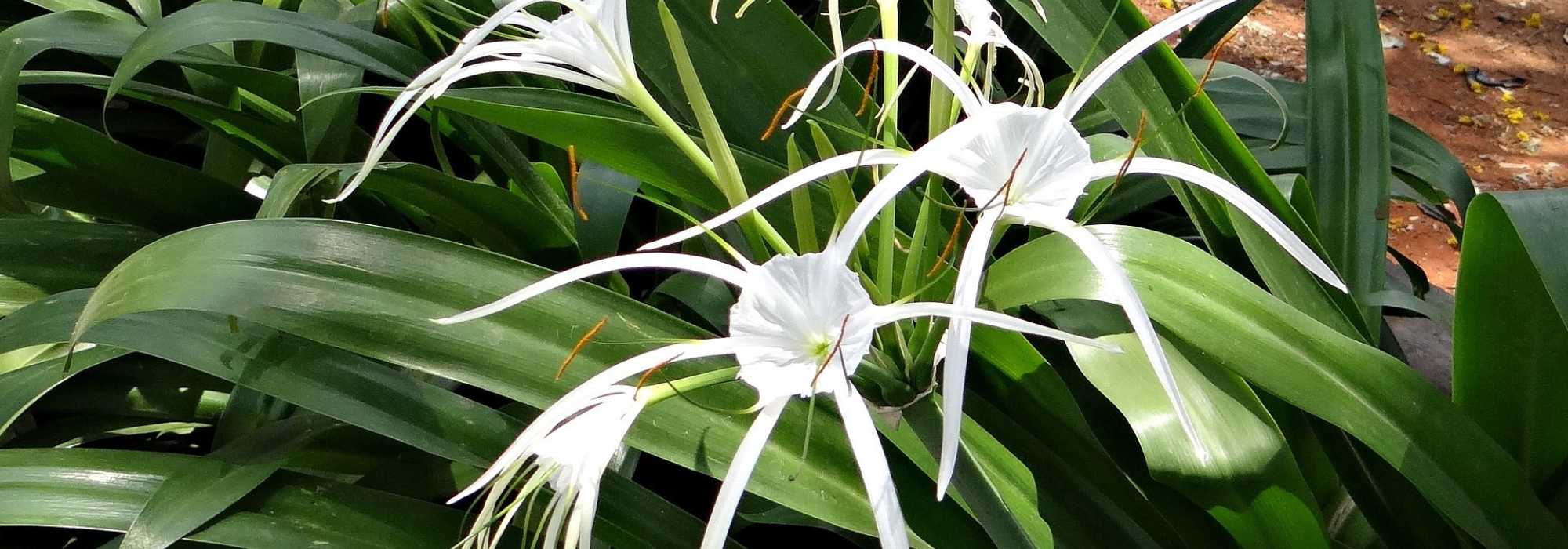
Spider lily: planting, growing, care
Summary
Spider lilies in a nutshell
- Spider lilies are plants of the family Amaryllidaceae belonging to two genera: Hymenocallis and Ismene.
- The strange shape of their six-petalled flowers resembles spiders.
- Their summer flowering is deliciously fragrant and very delicate.
- These bulbous plants are frost-tender and should be planted in spring, preferably in a pot or kept indoors in a conservatory.
- Floriferous, Ismenes require little care and are easy to look after.
A word from our expert
Spider Lilies are bulbous plants with magnificent flowers. White or sometimes yellow in colour, they give off a delightful fragrance. But their greatest asset is the astonishing and truly unique shape of their flower: six long, narrow petals form a spider-like shape at the tip of long flower stems.
Spider Lilies are relatively easy to care for and require only regular watering during their growth. Not demanding about soil, these bulbs are, however, very frost-tender and do not tolerate temperatures below 5°C.
They are an easy choice to add a touch of originality and exoticism to the garden. An unusual bulb that easily enchants.
Description and botany
Botanical data sheet
- Latin name Hymenocallis sp. and Ismene sp
- Family Amaryllidaceae
- Common names Spider Lily, Peruvian Daffodil
- Flowering March to June
- Height between 45 cm and 80 cm
- Sun exposure sun, partial shade
- Soil type well-drained, humus-bearing and sandy, low fertility
- Hardiness very low (down to 5°C)
Spider Lilies are bulbous plants whose various common names say everything about this plant’s strangeness: Peruvian Daffodil, Sea Daffodil, Spider Lily or Hymenocallis.
Formerly members of the Alliaceae family, Spider Lilies now belong to the large Amaryllidaceae family (alongside Amaryllis, Nerines and Agapanthus). Under one common name hide in fact two different genera: the Hymenocallis and the Ismene, with 65 and 105 species respectively. However, in strict botanical sense, only the Hymenocallis can be defined as Spider Lilies. By abuse of language, Ismene is sometimes used as a synonym of Spider Lily. The two genera are distinguished by leaf base — sheathing (as in a leek) in the genus Ismene but not in the genus Hymenocallis — by number of locules in the ovule and by the presence of a pedicel on Ismene flowers.
In addition to these two main genera, interspecific hybrids have been obtained between them. This is notably the case of d’Hymmenocallis x festalis, a hybrid resulting from a cross-breeding between Ismene longipetale and Hymmenocalis narcissiflora.
All come from tropical and subtropical regions of the Americas, in particular the lower Andean regions for the genus Ismene. It is this origin that makes them very vulnerable to frost. Depending on origin, Spider Lily species are divided into three categories: Tropical, Mexican and South American. In the wild they develop in meadows and rocky areas, which makes them tolerant of low soil fertility. Today, natural habitats where Spider Lilies grow tend to disappear, and with them these remarkable bulbs.
Spider Lilies are herbaceous and bulbous perennial plants. They have foliage that is most often deciduous but some species have evergreen foliage. These species are particularly sensitive to cold and cannot be lifted during winter. Reserve them for the warmest regions (no winter temperature below 5°C) or grow them in a winter garden. Leaves are large, erect, strap-shaped and a vivid green.
Above foliage rise in summer long flower stalks that can reach, in the tallest species, more than sixty centimetres. Each of these flower stems is several-flowered and can bear up to 5 flowers.
Flowers in umbels are most often white but sometimes yellow (notably Hymenocallis x festalis ‘Sulphur Queen’). They are relatively large, with a diameter of 10 to 15 cm. The six petals are thin and elongated, as are the long stamens that unfold at the centre of the flower. It is the resemblance of these stamens to spider legs that is said to have given the Spider Lily its name, unless it was the general shape of the flower. In any case, this flower continues to charm with its strangeness.
The long vase life of Spider Lily flowers makes them perfect for making bouquets.
You may also read
Planting Ismene bulbsDifferent varieties of Spider lily
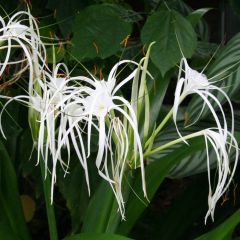
Hymenocallis longipetala - Spider Lily
- Flowering time july, august
- Height at maturity 60 cm
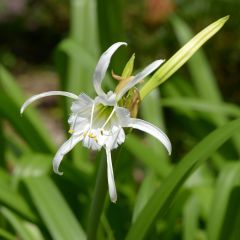
Hymenocallis festalis Blanche
- Flowering time july to september
- Height at maturity 50 cm
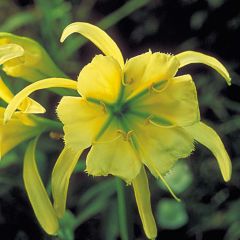
Hymenocallis festalis Sulphur Queen - Spider Lily
- Flowering time july, august
- Height at maturity 60 cm
Discover other Ismene
View All →Available in 0 sizes
Available in 1 sizes
Available in 1 sizes
Available in 1 sizes
Planting Spider lilies
Where and when to plant?
To best adapt the Spider Lily to your garden, take inspiration from its natural medium, the rocky meadows in warm regions of America. Spider Lilies prefer a well-drained, humus-bearing, sandy and poor soil. Beware of excess water that would rot the bulb.
If you plant your Spider Lilies in a pot, the ideal substrate will be a mix of potting compost, garden soil and river sand in equal thirds.
Spider Lilies are very frost-tender, so it is necessary to wait until the last risk of frost has passed before planting. Planting in May is ideal. In open ground, Spider Lilies are to be grown like Gladioli, lifting them from the soil before the first frosts. They will also do well in a winter garden, a conservatory or any other place protected from frost.
To slightly hasten flowering, you can also choose to plant earlier (around April) in a pot indoors, then move the pot outdoors when warmer weather arrives.
How to plant?
Due to their relatively large size, Spider Lilies are planted at a relatively low density. Allow about 8 to 9 bulbs per square metre. Prefer bulbs of large calibre (over 14 cm); number of flowers is directly correlated with bulb size.
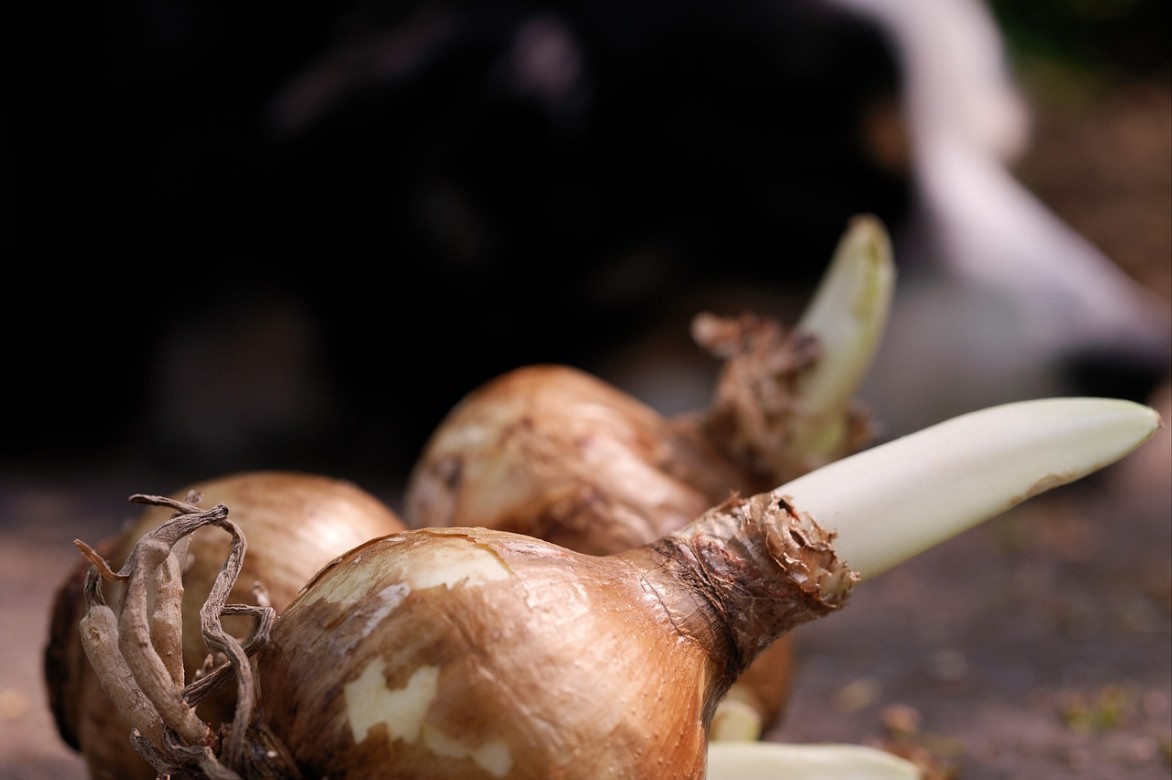
For planting in a pot, choose a pot with a diameter greater than 20 cm.
Planting in open ground
Before planting, if your soil is not sufficiently well-drained, do not hesitate to add sand to prevent bulb rot.
- Dig a hole about 10 cm deep and add any necessary amendments.
- Place the bulb at the bottom of the hole with the tip slightly showing at the surface.
- Cover with soil and firm lightly.
- Water moderately, even in winter.
Planting in a pot
- Place a layer of clay pebbles at the bottom of the pot to improve drainage.
- Fill the pot up to 10 cm from the rim with a mix of potting compost, garden soil and river sand in equal thirds.
- Place the bulb, the tip should slightly protrude at the surface of the pot.
- Cover with soil and firm lightly.
- Water moderately, even in winter.
Read our advice sheet: Planting bulbs and To grow Ismene in a pot
Propagation of Spider lilies
Bulbous plants, Spider Lilies multiply only by division of clumps. Sowing is so complex that it seems almost impossible to achieve under non-professional conditions. Each parent bulb (this is the name given to the large bulbs you buy) produces daughter bulbs, also called bulblets. In autumn, when the plant enters dormancy and you lift bulbs to protect them from frost, it is time to divide the plants. After lifting the bulbs, carefully detach each bulblet. In spring, when you replant your bulbs, plant bulblets separately from the mother plant. First year bulblets are relatively small and will probably not flower before second year. You can therefore also plant them in small buckets and wait until they are well developed before finding them a place in your garden.
Caring for Spider lilies
Generally free from diseases and pests (with a few exceptions), Spider Lilies are relatively easy-to-care-for plants.
During growth phase, and even more during flowering, regular watering is necessary to prevent the bulb drying out. Water thoroughly but allow soil to dry out between waterings so the bulb does not rot. After flowering, stop watering to encourage the bulb to enter dormancy.
After flowering, remove the flower stems to prevent seed set and help the bulb replenish its reserves. Take care not to cut foliage immediately but wait until it has completely yellowed (foliage is essential for the plant to store nutrients for the following season). You can also apply a bulb fertiliser after flowering.
In autumn, before first frosts, lift the bulbs and store them over winter. Keep them dormant all winter, dry and protected from frost at a temperature between 8 and 12°C.
Under glass or in a conservatory, whitefly attacks are possible, especially in warm conditions. You can move plants out of the greenhouse or ventilate to drive these small pests towards more suitable temperatures. Spray with a mixture of water and black soap (focusing on the undersides of the leaves, which whiteflies particularly favour) or try our companion-planting combinations to repel whiteflies.
Pairing Spider lilies
The ideal location for Spider Lilies is a conservatory or veranda. To create a lush, exotic setting for these flowers, pair them with Monstera, Cordylines or arborescent ferns. To combat whiteflies in a conservatory, plant bulbs in association with marigolds or basil.
Spider Lilies also do well outdoors, planted in open ground. You can pair them with Nerines or Agapanthus. For the latter, favour blue flowers that will contrast nicely with the white flowers of Spider Lilies.
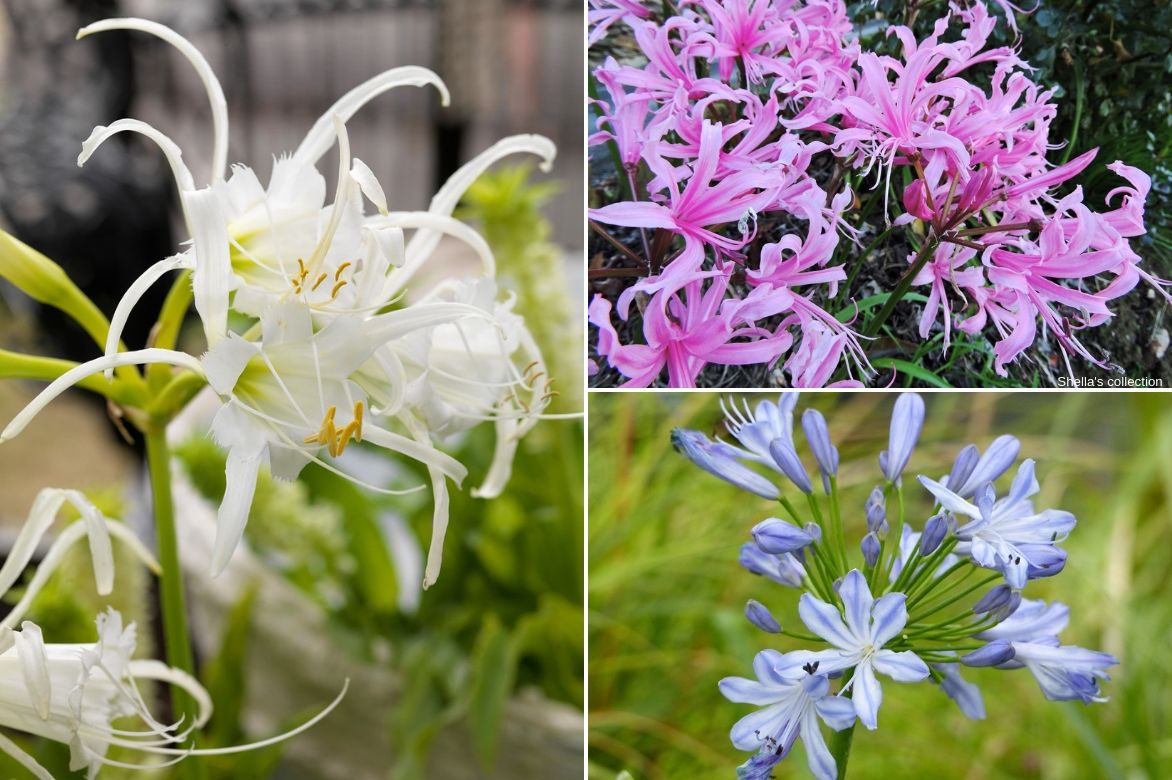
An idea for pairing: Hymenocallis festalis white, Nerine bowdenii and Agapanthus ‘Blue Heaven’
With their long vase life and delightful fragrance, Spider Lilies also make excellent cut flowers, paired with Agapanthus, or with foliage—fine-textured like Asparagus, or conversely very large leaves such as those of Monstera—for a composition full of contrast.
Finally, Spider Lily flowers are so striking that they also work very well on their own, revealing their full potential.
Did you know?
In autumn too!
There is another genus nicknamed the Spider Lilies but flowering in autumn: Lycoris. Like Ismene and Hymenocallis, these plants are relatively tender bulbous plants. Native to Asia, they flower in autumn then carry their foliage through winter. Plant them in a greenhouse, conservatory or winter garden. While summer-flowering Spider Lilies are only white or yellow, Lycoris display brighter colours: carmine red (L. radiata) or golden yellow (L. aurea).
A mythological origin
In Greek mythology, Ismene is the incestuous daughter of Oedipus and Jocasta but also a Naiad (goddess of springs).
Useful resources
- Discover our collection of Spider Lilies.
- Discover our ideas for pairing Ismene (Spider Lily).
- Learn all about botanical species of Hymenocallis and of Ismene.
- Discover other rare bulbs and learn how to plant them.
Frequent questions
-
Can I leave my spider lilies in the garden all year round?
Spider lilies are very tender plants and planting in open ground should be reserved for warmest Mediterranean regions where winter temperatures never fall below 5°C. Elsewhere, lift and bring bulbs indoors in autumn and plant out once danger of late frosts has passed.
-
Leaves of my spider lilies are covered with a waxy coating — what should I do?
This waxy film is one of the main symptoms of greenhouse whitefly. This insect particularly favours warm temperatures. So take your plants outside the greenhouse, spray the leaves with a mixture of water and black soap, and if nothing works, use an organic treatment for whiteflies.
-
My spider lily is producing a sort of green fruit — can I sow it?
Yes, you can still sow these seeds while they are green and at a temperature of about 20–25°C. However, chances of obtaining a flowering plant are virtually nil. After many months, seeds may develop roots and, with a lot of luck, a small bulblet. But no formation of aerial organs (stem or leaf) has been reported, and conditions required for that bulblet to thrive are completely unknown. Sowing is therefore generally not recommended.
- Subscribe!
- Contents
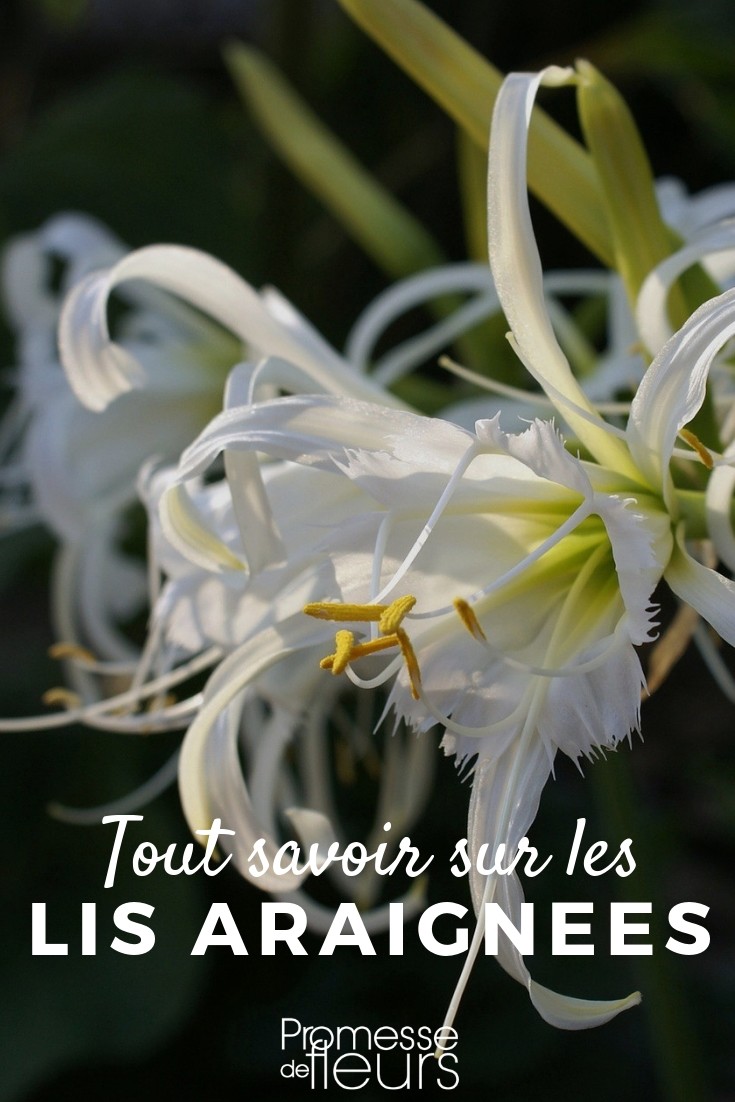































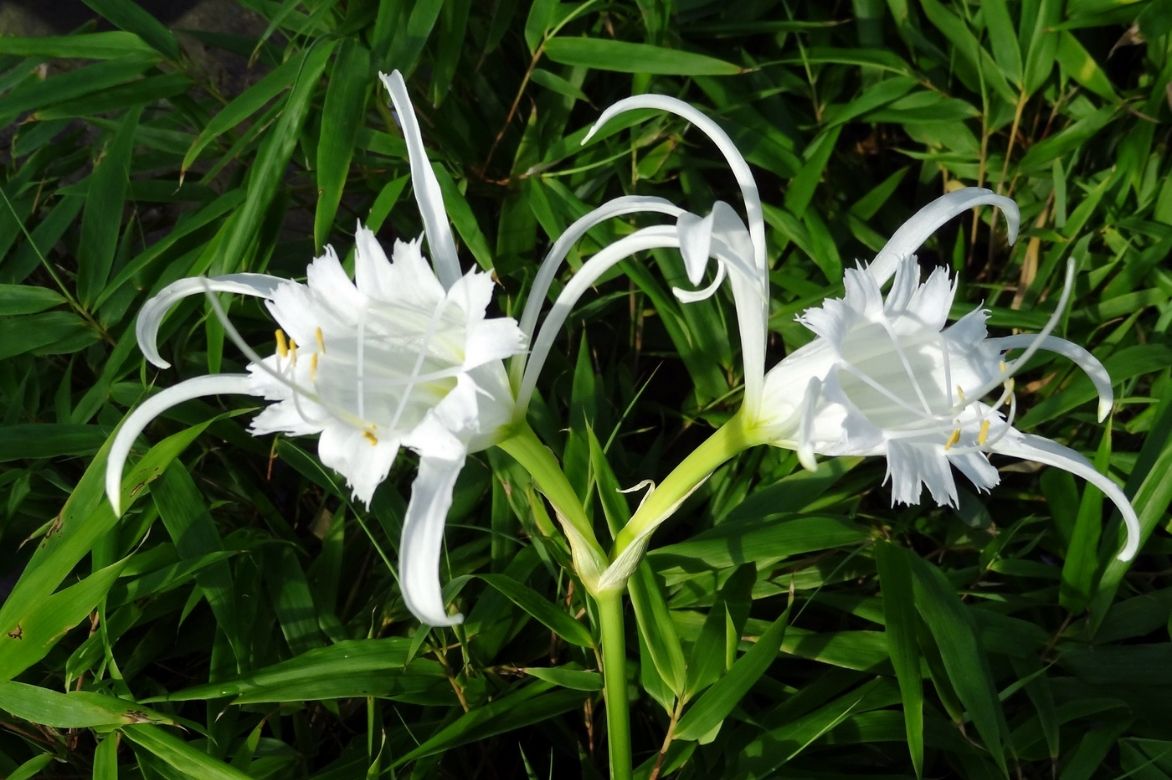
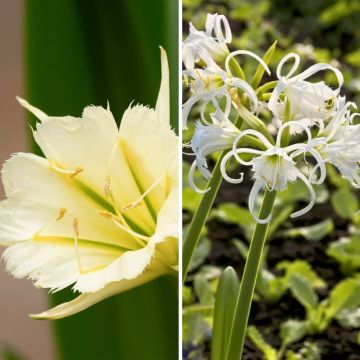



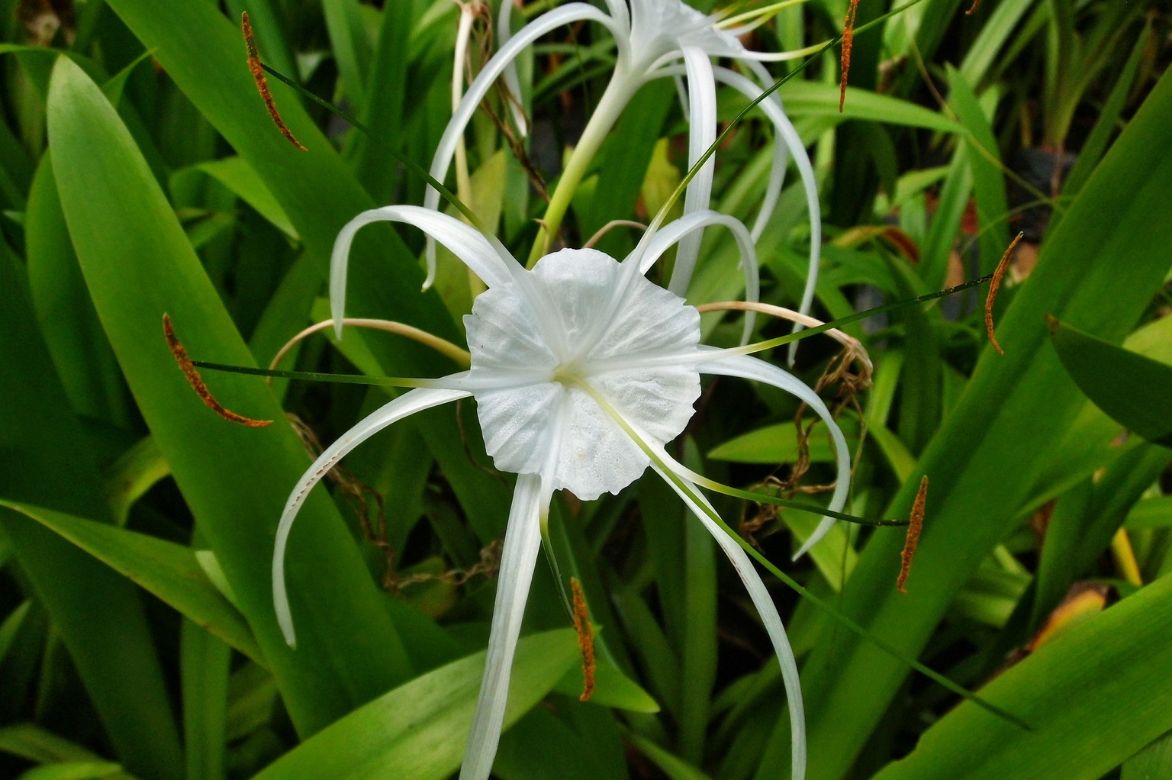
Feedbacks